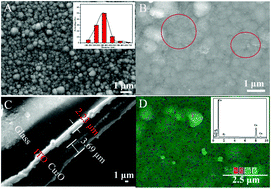当前位置:
X-MOL 学术
›
J. Mater. Chem. C
›
论文详情
Our official English website, www.x-mol.net, welcomes your feedback! (Note: you will need to create a separate account there.)
A PPy/Cu2O molecularly imprinted composite film-based visible light-responsive photoelectrochemical sensor for microcystin-LR†
Journal of Materials Chemistry C ( IF 6.4 ) Pub Date : 2018-03-02 00:00:00 , DOI: 10.1039/c7tc05743a Junli Chen 1, 2, 3, 4, 5 , Pan Gao 6, 7, 8, 9, 10 , Hai Wang 1, 2, 3, 4, 5 , Lifeng Han 1, 2, 3, 4, 5 , Yonghui Zhang 1, 2, 3, 4, 5 , Peiyuan Wang 1, 2, 3, 4, 5 , Nengqin Jia 6, 7, 8, 9, 10
Journal of Materials Chemistry C ( IF 6.4 ) Pub Date : 2018-03-02 00:00:00 , DOI: 10.1039/c7tc05743a Junli Chen 1, 2, 3, 4, 5 , Pan Gao 6, 7, 8, 9, 10 , Hai Wang 1, 2, 3, 4, 5 , Lifeng Han 1, 2, 3, 4, 5 , Yonghui Zhang 1, 2, 3, 4, 5 , Peiyuan Wang 1, 2, 3, 4, 5 , Nengqin Jia 6, 7, 8, 9, 10
Affiliation

|
In this study, a visible light-responsive photoelectrochemical (PEC) sensor based on a PPy/Cu2O molecularly imprinted composite film for microcystin-LR (MC-LR) has been fabricated. Uniform Cu2O nanoparticles were electrodeposited on a pretreated indium-doped tin oxide-coated glass (ITO) by carefully controlling the deposition process and used as a photocatalyst to produce photocurrent under visible light. Subsequently, molecularly imprinted polypyrrole (PPy) was modified on the surface of the Cu2O/ITO electrode by an electropolymerization process, which created a certain amount of special recognition sites to enhance the selectivity of the electrode to MC-LR. PEC molecular imprinting sensors were used to rapidly analyze MC-LR concentration by determining changes in photocurrent density. The results showed that the change of photocurrent density was linearly proportional to the logarithm of the MC-LR concentration over the ranges from 1.0 ng L−1 to 100 ng L−1 and from 100 ng L−1 to 10.0 μg L−1 with a low detection limit of 0.23 ng L−1 (S/N = 3). Moreover, the PEC sensors exhibited specific selectivity to MC-LR when exposed to certain concentrations of interfering solutions. The constructed PEC sensors demonstrated good applicability in local water systems; this suggested that this promising application of integrating PEC and molecular imprinting technology could be applied to detect other contaminants of emerging concern.
中文翻译:

基于PPy / Cu 2 O分子印迹复合膜的可见光响应型光电化学传感器,用于微囊藻毒素-LR †
在这项研究中,基于PPy / Cu 2 O分子印迹复合膜的微囊藻毒素-LR(MC-LR)的可见光响应光电化学(PEC)传感器已被制造。通过仔细控制沉积过程,将均匀的Cu 2 O纳米粒子电沉积在预处理的掺铟锡氧化物涂层玻璃(ITO)上,并用作光催化剂以在可见光下产生光电流。随后,在Cu 2的表面上修饰分子印迹的聚吡咯(PPy)O / ITO电极通过电聚合过程产生了一定数量的特殊识别位点,以增强电极对MC-LR的选择性。PEC分子印迹传感器用于通过确定光电流密度的变化来快速分析MC-LR浓度。结果表明,光电流密度的变化是线性地正比于MC-LR浓度超过所述范围的对数为1.0纳克大号-1至100ng大号-1和100纳克大号-1〜10.0微克大号-1与低检测限0.23 ng L -1(S / N = 3)。此外,当暴露于某些浓度的干扰溶液中时,PEC传感器对MC-LR表现出特定的选择性。构造的PEC传感器在本地水系统中显示出良好的适用性;这表明,将PEC与分子印迹技术相结合的这一有前途的应用可用于检测新兴关注的其他污染物。
更新日期:2018-03-02
中文翻译:

基于PPy / Cu 2 O分子印迹复合膜的可见光响应型光电化学传感器,用于微囊藻毒素-LR †
在这项研究中,基于PPy / Cu 2 O分子印迹复合膜的微囊藻毒素-LR(MC-LR)的可见光响应光电化学(PEC)传感器已被制造。通过仔细控制沉积过程,将均匀的Cu 2 O纳米粒子电沉积在预处理的掺铟锡氧化物涂层玻璃(ITO)上,并用作光催化剂以在可见光下产生光电流。随后,在Cu 2的表面上修饰分子印迹的聚吡咯(PPy)O / ITO电极通过电聚合过程产生了一定数量的特殊识别位点,以增强电极对MC-LR的选择性。PEC分子印迹传感器用于通过确定光电流密度的变化来快速分析MC-LR浓度。结果表明,光电流密度的变化是线性地正比于MC-LR浓度超过所述范围的对数为1.0纳克大号-1至100ng大号-1和100纳克大号-1〜10.0微克大号-1与低检测限0.23 ng L -1(S / N = 3)。此外,当暴露于某些浓度的干扰溶液中时,PEC传感器对MC-LR表现出特定的选择性。构造的PEC传感器在本地水系统中显示出良好的适用性;这表明,将PEC与分子印迹技术相结合的这一有前途的应用可用于检测新兴关注的其他污染物。



























 京公网安备 11010802027423号
京公网安备 11010802027423号